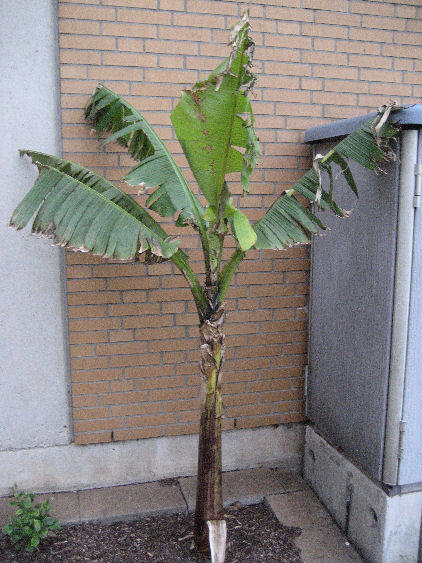
Banana Flower April 2009 On Heligoland
Bananas on Heligoland? There I was very sceptical because of low summer warmth and strong sea winds at first. Nevertheless I had to notice on Heligoland that it really can get very warm at least at sunny places sheltered from the wind, these places would be also suitable for bananas, if one collects rain water into wells and tries through this particularly limiting the drinking water consumption since drinking water is expensive on Heligoland.
Mr. Neulen reported that bananas shall already have been tentative cultivated from Berlin and Dresden at 1900 in the area of today's ornithological station on the Upper Land. Nothing more can be seen from bananas on Heligoland today, only as potted plants in heated rooms or in the fruit department of the EDEKA supermarket. I couldn't get a nearer information about the tests at 1900 on Heligoland yet but a Berlinian acquaintance of ours has started with the investigations. The results being with me till now mean that one had really planted a Musa japonica on Heligoland in spring 1906 out. But it didn't survive the following winter. Since it froze to death, it probably couldn't be Musa basjoo, probably Musa balbisiana. Musa balbisiana is the Unique Japanese Fiber Banana and Musa basjoo is the False Japanese Fiber Banana, is also named the Garden Banana because of its hardiness. Musa balbisiana is more tender than Musa basjoo, but there are hardier origins, already one survived in the Kölner Flora (Botanical Garden in Cologne/Germany) several winters and is still living today.
The situation is different today, more hardy banana species and cultivars are known now, I self have overwintered bananas in Hamburg/Germany successfully. My Musa basjoo already has its 9th winter behind itself here and has survived. There would be much more success possiblities than at that time today, particularly since many of the hardy species and varieties have found entrance at us only within the last years, like e. g. Musa sikkimensis, basjoo cultivars like e. g. 'Sapporo', Musa itinerans, 'Rajapuri', 'Orinoco' and the others. Even I wrote one book about bananas in Germany, the English version is in preparation and one Portuguese/Brazilian version is planned.
In Spring 2006 I sent one corm of Musa basjoo 'Sapporo' to Ulf and let outplant it at the power station closed to the entrance into one well protected corner. The banana developed much better than the others in the garden of the hotel 'Insulaner' and in the atrium of the James Krüss School and grew to the largest banana tree of Heligoland! It's totally clear, that bananas need one profound sandy soil, they do find only on the Northeast Area and probably also on the planned new isthmus of Arne Weber between the main island and the dune. That bananas also grow well in sandy soils and even do fruit, this is proven also at my secondary residence in Brazil, in my new yard is sandy soil too, at the same bananas, mangos, coconuts, citrus fruits, ananas, jackfruits and others are thriving very well and are fruiting very well and give good harvests. On windier places and on rocky grounds with thin layer of topsoil or lime layer the bananas reached only 1 to 2 feet and survived despite of this without winter protection. To be successful with bananas on Heligoland, one has to choose one sunny, warm and very well windsheltered site with profound sandy soil on the island, unfortunaely only few suitable places do exist. One of these is at the power station! And one has to water the bananas in the summer regulary. We really had luck to find anyone who is keeping our banana at the power station! The climate of Heligoland is so mild, that the bananas do never need winter protection, in the difference to the on the mainland! One can forget the Karlsruhian compost method (one of the powerful winter protection methods for outdoor overwintering of bananas) on the island! And this with success, which you do see now!
Banana flower after outdoor overwintering totally without winter protection in Germany possible? YES, but only on Heligoland! Otherwise you has to go to Ticino to the Southern Switzerland to find really banana flowers without winter protection! On 29th April 2009 I obtained one email with pics of one employee of the power station, Mr. Udo Harlichs, and downloaded the pics. I was very amazed! I saw pics of one inflorescence of Musa basjoo 'Sapporo' at the power station! This has evenas Prof. Dr. P. Kuckuck in the year of 1906 never reached with his Musa japonica! The naked pseudotrunk has survived the past winter well and the leaves were destroyed by the strong winds during the winter, despite of this the naked pseudotrunk got one inforescense! And the flowers were already opened, at the first the female flowers open, at the least the male. But the pollination is not possible, because one second banana tree is missing, which already flowers with male flowers. The plant will not die, it will sucker.

Musa basjoo 'Sapporo' at the power station in December 2007, one year after the outplantation.
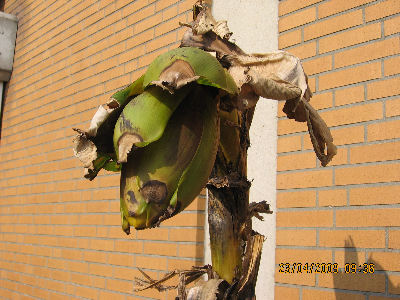
Musa basjoo 'Sapporo' at the power station with inflorescence at the leafless pseudotrunk on 23th April 2009, 3 years after the outplantation.
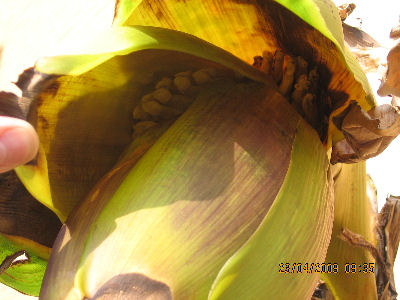
Closer view of the inflorescence of Musa basjoo 'Sapporo' at the power station.
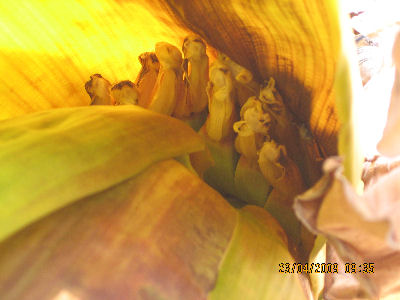
Female flowers of Musa basjoo 'Sapporo' at the power station.
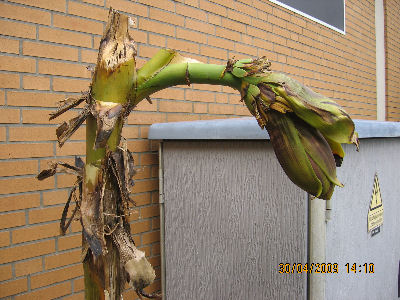
Total pic of the Musa basjoo 'Sapporo' at the power station on 30th April 2009.
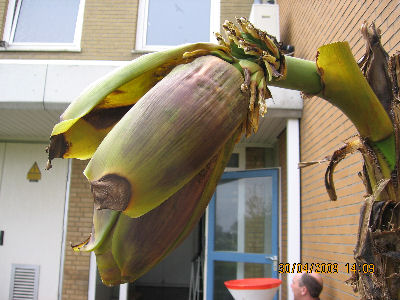
Closer view of the female flowers of Musa basjoo 'Sapporo' at the power station on 30th April 2009, begining fruiting. The fruits will hardly ripe by the lack of pollination.
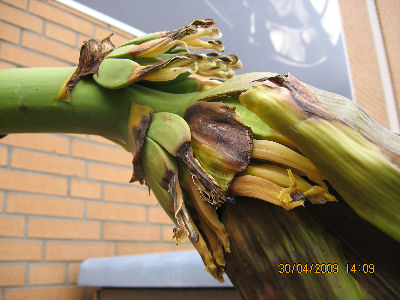
Close view of the fruiting of Musa basjoo 'Sapporo' at the power station.
Author: Joachim Jäck
Created on May, 1st, 2009